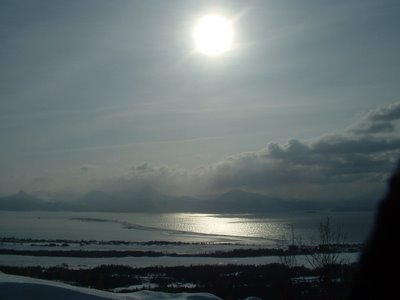 Well, I'm back to my Monday night routine, running on the hamster wheel at the gym, thereby inadvertently devoting an hour to wandering thoughts about ways to make life more interesting.
Well, I'm back to my Monday night routine, running on the hamster wheel at the gym, thereby inadvertently devoting an hour to wandering thoughts about ways to make life more interesting.Today, for no reason, a mundane conversation I had with a coworker about a year ago suddenly popped into my head. It's been buried in the back of my mind, and I have no idea why it's even stored in my long-term memory - except as a glaring statement on how much I've changed since I moved to Alaska.
My coworker was training for the upcoming cycling season, and was trying to plan a fitness routine he could stick with. He hated the hamster wheel/spinning bike/whole indoor workout setup more than anyone I know. So he asked me what I knew about studs that you could attach to bike tires. He thought they might help him navigate icy Idaho highways during longer rides.
I remember shooting back a reply that was something along the lines of "That's crazy. Why in the world would you want to ride outside in the winter when you have a well-lit, climate-controlled gym at your disposal?" (I was a big hamster wheel advocate at the time.)
He told me he was training for a double century, and needed to keep a pretty strict routine that required him to step up his mileage soon. And he just couldn't put in the time indoors.
"But that's crazy," I replied. "Why would anyone want to ride a double century?"
Not only did I not have any advice to offer, but the whole idea turned my stomach. I promptly forgot the unpleasantness - until today, only one year later. I'm still plugging away on the hamster wheel, but this time with big dreams of double triple-digits running through my head.
There are a lot of things I want to do this summer, but I think the first event I might like to plan for is the Fireweed 200, a 200-mile highway ride from Sheep Mountain to Valdez. The race is slated for July 8. That's a little too close to 24 hours of Kincaid (June 24) to feasibly train for both (there's another similar event I specifically told another coworker she was "crazy" for doing - in her case, the 24 hours of Moab race.) So I do have to make some decisions, and map out a plan. The Fireweed 200 has a nondrafting division that appeals to the rabid soloist in me, so my early pull is for the road race. (However, some have suggested that I consider riding the entire Fireweed 400. While I do have a plug-along attitude that has gotten me through some tough spots, I'm not exactly an ultra athlete - and the Fireweed 400 is not only Four Hundred Nonstop Miles, but also 28,000 feet of climbing! UltraRob has done it. But UltraRob is UltraRob. He's one of those RAAM people that even the current me would call crazy.)
But I am excited about the prospect of training for and riding in these "ultra" races - if nothing else, to spite my 2005 self for being so self-depreciating and cynical. I do not need Cat 5 status or quads of steel to ride 200 miles or spend 24 hours on a mountain bike. I have love! I have Power Bars! I'm good to go.







